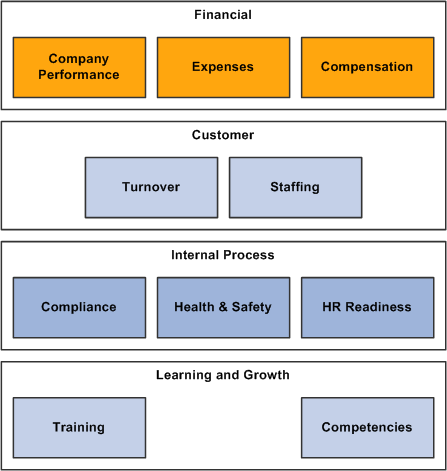Understanding Workforce Scorecard
The Workforce Scorecard is a component of a larger company-wide scorecard that facilitates the measurement and communication of human resources objectives and performance across the enterprise. Following the basic tenets of scorecard theory, KPIs within the Workforce Scorecard are used to evaluate how well employees are carrying out the internal initiatives necessary to serve their customers, how those initiatives are associated with the financial and strategic goals of the organization, and how efficiently and effectively all employees in the organization are performing. Used in this manner as an organizational and communications tool, the Workforce Scorecard supports the shift of the human resources function from an administrative entity to a key strategic partner.
Some benefits of using the Workforce Scorecard are:
Linking human resources KPIs to corporate-wide objectives using an Enterprise Scorecard approach.
Quickly comparing current company practices to internal historical measures and external benchmarks.
Measuring and aligning your human resource initiatives within a business framework.
Accurately determining and tracking the composition and deployment of the workforce.
Enabling easy access to information by distributing reporting results through the internet.
This topic discusses:
Integrations
Scorecards and strategy components
Key Performance Indicators
Batch processes
Integrations
The Workforce Scorecard is part of the Recruiting, Development, Deployment, and Reward business processes.
The Workforce Scorecard works in conjunction with Scorecard and the Workforce Data Mart. The Workforce Scorecard uses Scorecard's tools to provide a current representation of how the company is meeting its human resources objectives. The Workforce Data Mart provides details and analysis of how and why these trends are occurring.
Data flows through the Scorecard application based on a defined frequency. Transactional data is provided to PeopleSoft EPM where it is transformed using the Scorecard analysis tools. The system displays analysis results through the Workforce Data Mart to users who can use this information to analyze trends or take actions as necessary. For example, you can analyze details such as job demographics, personal demographics, and compensation.
Scorecards and Strategy Components
The Workforce Scorecard is a view of your company's human resource objectives and performance. The scorecard's foundation is a strategy tree that is comprised of hierarchical nodes of strategy components.
Strategy components are the elements that make up your strategy, and are the nodes on your strategy tree or tables. Vision, strategic thrusts, and critical success factors are all strategy components, and represent the goals that your organization is trying to achieve. KPIs, which measure how well an organization is achieving those goals, are attached to scorecard strategy components, which are typically critical success factors.
The predefined data components that make up the Workforce Scorecard are delivered separately from the Scorecard application. These components are delivered at the time of installation. After the database is installed at your site, setting up and accessing the Workforce Scorecard involves setting up and populating PeopleSoft EPM, updating several components of the scorecard, and populating the final reporting tables.
Note: Before you attempt to set up the Workforce Scorecard, you should have installed the appropriate components using the installation documentation and moved the appropriate data components to your system database.
The predefined data components, as delivered, are set up to run with a specific business unit, SetID, model ID, scenario ID, and so on. All of the appropriate security and object IDs are delivered as sample data. If you install the Workforce Scorecard to a demo database, you can acquaint yourself with the functionality in a demo environment. Using the delivered scorecard is optional, and you can modify it to suit your implementation.
This table lists the field values for this scorecard:
KPIs
KPIs define the data value or calculation, from the PeopleSoft EPM warehouse tables, that is used to determine how well your organization is meeting its critical success factors.
The Workforce Scorecard delivers a set of predefined KPIs that provide executive and middle management with a representation of human resources-related activity. These predefined KPIs have been developed in conjunction with leading human resource and management consultants. The KPIs are linked to a set of critical success factors that cover all facets of human resources activities.
The following illustration is an example of critical success factors for a workforce scorecard:
Image: Workforce Scorecard critical success factors
Workforce Scorecard critical success factors

Using the predefined KPIs as a baseline, human resources and company management can view company performance for these critical success factors by business unit or department. Easy and timely access to this information enables management to track progress toward company goals and to take immediate action when necessary.
Batch Processes
You must run the following jobstreams to populate key tables:
KP_ANALYZE
This jobstream populates KP_KPI_CALC_F00 and KP_KPI_ASMT_F00. Run this jobstream to validate the KPI calculation rules, verify end values, and test the KPI assessment rules.
BC_ANALYZE
This jobstream populates KP_KPI_CALC_F00, KP_KPI_ASMT_F00 and BC_ASSESS_F00. Run this jobstream to generate the final scorecard assessments after you validate your setup (by running KP_ANALYZE). If you set up this job to run regularly, the KPI process can aggregate data month-to-month and year-to-date. You must run this process after you populate or update the PeopleSoft EPM warehouse tables (such as during the ETL process) to view current results for your Workforce Scorecard.